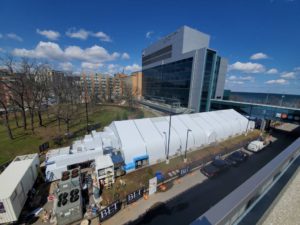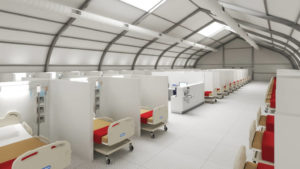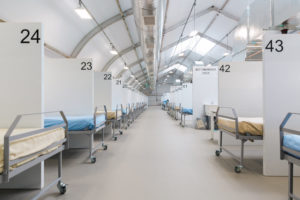Sprung instant structures and the fight against COVID-19
By David Thompson
In late 2019 to early 2020, COVID-19 took the world by surprise. It disrupted how people do business worldwide. Responding to the pandemic has opened doors for all businesses and industries (including the construction industry, consultants, and constructors) to be creative in their responses to new challenges.
The planning, design, and construction of hospital facilities normally take years. However, the pandemic presented a unique challenge where solutions had to be conceived and implemented within months. This is the story of one response to this unique challenge.

Shortly after the World Health Organization (WHO) identified COVID-19 as a pandemic, and with the concerns raised by Canada’s early casualty projections, provincial governments realized the pandemic numbers could quickly overwhelm their health-care systems. More treatment capacity was required. Health regions identified a need for additional beds that could be housed in open wards. One solution was constructing a facility (an open ward) on a hospital’s parking lot and connecting it to the main building. The site could be returned to its original use afterward.
Building firm Sprung Instant Structures, in conjunction with contractors, provided a solution in two provinces—Ontario and Alberta. The solution was a 15.24 x 45.7-m (50 x 165-ft) structure made with high-performance tension fabric with an adjustable floor system. The structure is able to accommodate between 70 to 100 beds with a 3-m (10-ft) connecting, enclosed corridor to the main hospital (Figure 1).
As of June 2020, four temporary facilities have been completed: the Joseph Brant Hospital, (Burlington, Ont.), Royal Victoria Regional Health Centre (Barrie, Ont.), Trillium Health Partners (Mississauga, Ont.), and Peter Lougheed Centre (Calgary, Alta).
The industries’ responses to COVID-19 demonstrated that, despite challenges, large hospital facilities can be constructed in days, not years.

Photos courtesy Sprung Instant Structures
Ontario temporary facilities
The construction team consisted of BLT Construction Services, Mulvey & Banani Consulting Engineers, the HIDI Group, KTA Structural Engineers and Truetek Engineering Inc., Cumulus Architects Inc., and the owner’s representative Infrastructure Ontario, Colliers. These companies worked together to meet the diverse needs of their clients.
Two health centres required an infectious disease ward specifically for COVID-19 patients, and one of the two required a facility for use in the winter. Another centre required a ward for non-COVID-19 patients in order to free up regular hospital beds (Figure 2).
The construction team had to build on uneven parking lots. The structure is designed to accommodate changes in elevation. To create a level floor surface, an adjustable floor system was used. The structure was anchored to the ground using ballast weights and 20 x 300-mm (3/4 x 12-in.) steel pins. Two structures for COVID-19 patients used negative pressure. The two other structures employed static pressure. One structure was insulated for use during the winter, and two were left uninsulated to speed up construction.
According to Paul Waddell, vice-president, design and build, for BLT Construction Services, what made the project work well was “…the co-operation between all parties involved, including the owner’s representatives…the clients were satisfied with the quality of the facilities, especially considering the short time of construction.”
The Joseph Brant facility was designed, shipped, and constructed in 14 days. The Royal Victoria facility was completed on in 30 days. The Trillium Health Partners was completed in 24 days.

Calgary temporary facility
In Alberta, the design/construction team consisted of CANA Construction, Stantec, Sprung Instant Structures, and KTA Structural Engineers. The size of the structure and the floor anchoring method mirrored the Ontario structures. However, this structure had to accommodate a site elevation slope of 900 mm (35 in.). A wood crib foundation was used to create a level working surface. As soon as the owner approved the project, construction and design began simultaneously. Alberta Health Services and Stantec completed the programming in three days (a project that involved 50 people including various user groups). For this project to be a success, there had to be co-operation and communication between all parties. This facility has static pressure, and it was left uninsulated to accelerate construction (Figure 3).
“The project was completed in 17 days from conception to turn over to the client, ahead of time, and under budget,” said Jim Avery, vice-president, Sprung Instant Structures. “The clients were surprised at the quality of the project.”
To achieve this schedule and prevent delays, daily onsite presence and attention of senior structural engineers was required. The real-time modification of structural systems and accommodation of alternative components and construction methods required in-depth knowledge of the structure’s behaviour. Having the manufacturer’s technical representatives onsite for the duration of construction helped ensure the quality and speed of construction (Figure 4).
Instant structure design and materials
All of the structures were fabricated at Sprung’s headquarters at Aldersyde, Alta. The design of, and the materials used in, the structures lend themselves to meeting the challenges of rapid design and construction. Waddell observed the structures had the most permanent features for an assembly occupancy in a temporary facility, and that the ones erected in Ontario met the requirements of the Ontario Building Code (OBC) and building envelope requirements.
Often, when people look at fabric structures, they assume them to be simple tents. Nothing is further from the truth. Present-day fabric structures are the result of years of research and development. The temporary structures described in this article can be used in all the Major Occupancy Classifications from Assembly Group A Division 1 to low-hazard industrial occupancies Group F Division 3.
SIDEBAR (Wide)
| CONSTRUCTION SEQUENCE FOR PETER LOUGHEED FACILITY |
| Wednesday, April 8, 2020.
Day 1: Notification of start of work. Concept of foundation system. Materials delivered to site. Programming of facility started. Day 2: Three senior structural engineers brought on to site (including a specialist with over 40 years’ experience in wood design) to verify the viability and enable the method of construction the construction manager wished to use. This meeting devised workable connection details and finalized wood framing concepts. Sketches provided for wood framing details. Analysis of Sprung structure. Day 3: Six of 12 arches erected. Wood foundation 50 per cent completed. Redesign of foundation. Day 4: All arches erected. Half of membrane installed. Programming completed. Modification of foundation anchorage. Day 5: All membrane installed and stretched. Corridor started. South end installed. Modification of foundation to accommodate construction sequence. Day 6: Flooring system started. Day 8: Sprung structure completed except for doors. Corridor under construction. Floor system completed. Day 10: Mechanical duct work being installed. Floor system and corridor under construction in the main building. Checked utility loads. Day 11 to 16: Internal gas and electrical installed. Frame out of partitions. Mechanical units installed. Day 17: Substantial completion (including beds and work stations) and turn over to hospital. |





